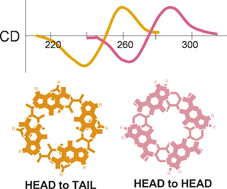A non-empirical chromophoric interpretation of CD spectra of DNAG-quadruplex structures†
Abstract

* Corresponding authors
a
Alma Mater Studiorum–Università di Bologna, Dipartimento di Chimica Organica “A. Mangini”, via San Giacomo 11, Bologna, Italy
E-mail:
gianpiero.spada@unibo.it
b
Università di Napoli “Federico II”, Dipartimento di Chimica delle Sostanze Naturali, via D. Montesano 49, Napoli, Italy
E-mail:
antonio.randazzo@unina.it

 Please wait while we load your content...
Something went wrong. Try again?
Please wait while we load your content...
Something went wrong. Try again?
S. Masiero, R. Trotta, S. Pieraccini, S. De Tito, R. Perone, A. Randazzo and G. P. Spada, Org. Biomol. Chem., 2010, 8, 2683 DOI: 10.1039/C003428B
To request permission to reproduce material from this article, please go to the Copyright Clearance Center request page.
If you are an author contributing to an RSC publication, you do not need to request permission provided correct acknowledgement is given.
If you are the author of this article, you do not need to request permission to reproduce figures and diagrams provided correct acknowledgement is given. If you want to reproduce the whole article in a third-party publication (excluding your thesis/dissertation for which permission is not required) please go to the Copyright Clearance Center request page.
Read more about how to correctly acknowledge RSC content.
 Fetching data from CrossRef.
Fetching data from CrossRef.
This may take some time to load.
Loading related content
